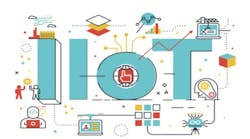What’s the value of a standardized ecosystem in the era of IIoT?
By Glenn Schulz, managing director for FDT Group
Today’s suppliers of industrial-control systems and devices want to seize emerging opportunities for Industrial Internet of Things (IIoT) solutions by enhancing their product offerings with standards-based, platform-independent, information-driven business models for the new era of automation.
The vendor community has good reason to focus on emerging opportunities within the IIoT. Despite the enormous potential of the IIoT, no company or organization has the resources to do it all in this market space. Instead, businesses targeting IIoT opportunities must be part of an ecosystem.
Path to digitalization
Advanced sensing, data analysis and communication techniques have led to the growth of the IIoT in recent years. This has resulted in a revolution in condition monitoring and maintenance for industrial-automation assets.
Digitalization of plant automation and maintenance strategies through the IIoT offers many benefits to the control and instrumentation community, but it also brings challenges such as real-time data access, end-to-end security, and multi-vendor integration and interoperability. Additionally, there is a growing need to mobilize real-time remote operations and expand secure access to device and network data in order to increase productivity and create safer workplaces.
An open development environment needs to be established for users to freely interact with field devices and servers via web or mobile applications, increasing IIoT scalability and flexibility. However, current solutions are typically developed by a single developer or company, whose core technology and data are inaccessible to other parties. This approach operates in a closed and rigid manner, with limited scale and functions.
In the era of IIoT and Industry 4.0, it is crucial to have a standardized ecosystem that promotes comprehensive interoperability and simplifies integration and communication for both automation suppliers and the end users they serve. An IIoT ecosystem can meet these requirements by allowing new network solutions to plug right in while making it easy for vendors to develop and customize products based on market demand.
Ensuring compliance to standards
The end-user community demands that a solution built upon IIoT standards delivers on its value proposition. To this end, many users insist upon a “certification of conformance” from the standards organization before specifying the vendor’s products. Due to the highly adaptable nature of IIoT, these conformance tests must cover a wide range of test cases—directly opposing the rapid time to market consideration that the fast-paced IIoT market fuels.
Vendors must take care to evaluate the ecosystem for pre-engineered and pre-tested tool kits for their chosen standard in order to swiftly and successfully move through the development and certification procedures. The key components of a successful IIoT ecosystem are deployable using integrated development environment (IDE) tools, which help to “lower the bar” for automation companies seeking to implement innovative business models while optimizing developer and testing performance.
IDE toolkits greatly reduce the burden of development work and save time and money when bringing new product offerings to market. Vendors should ensure that their IDE toolkits for the standard produce code that is platform- and operating system-independent...a hallmark of the varietal applications of IIoT.
Support for the future
Interoperability and integration underpin the future development environment for the IIoT. Unlike traditional approaches where most data are inaccessible to users, a standardized and open ecosystem is a key asset for developers seeking to design modernized applications based on their own customer demands.
The future is bright for standardized ecosystems, those that reside at the heart of today’s automation architecture, connecting legacy and new technologies now on the horizon. Indeed, the new standards technology is helping to flatten the automation pyramid by adding new channels for direct access to real-time automation.
This standardized ecosystem promises to be a crucial enabler for scalable, remote-access business solutions and services that are required to meet changing market demands in the evolving industrial automation sector.



